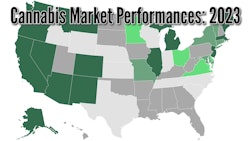
Connecticut celebrated its one-year anniversary of adult-use cannabis sales Jan. 10, and industry stakeholders say that, as in all state markets, the rollout has been bumpy due, in part, to limited product variety, supply constraints and competition from the unregulated market.
Connecticut Gov. Ned Lamont signed the state’s adult-use cannabis law, an Act Concerning the Responsible and Equitable Regulation of Adult-Use Cannabis (RERACA), in June 2021. The law allowed licensed medical cannabis operators to launch adult-use sales, and the state established a social equity licensing program that allowed applicants who meet certain income and residency requirements to partner with economic backers to apply for additional adult-use licenses. Retail licenses must be at least 50% owned by a social equity applicant, while cultivation licenses must be at least 65% owned by a social equity applicant.
Higher Collective, a Connecticut-based collective made up of industry veterans, is one of the social equity joint ventures operating in the state. The company operates its cultivation facility, four dispensaries (with additional locations expected to open this spring) and a delivery service with social equity partners in Connecticut.
“The implementation of the adult-use cannabis program in Connecticut has been commendable in terms of its operational efficiency,” Higher Collective founder Patrik Jonsson tells Cannabis Business Times. “As we understand it, the initiation of sales through existing medical cannabis retailers went smoothly. Connecticut selected a controlled number of producers and retailers to open beyond that, which we were honored to be included in through the state’s Equity Joint Venture program. This allowed us to significantly expand our market presence and leverage our expertise in serving adult-use customers.”
Jonsson says the company’s dispensaries in Hartford, Willington, Killingly and New London—all operated in partnership with social equity partners—demonstrate Higher Collective’s commitment to “providing inclusive spaces while simultaneously creating opportunities for social equity applicants in Connecticut's cannabis landscape.”

Connecticut established a Social Equity Council (SEC) to focus on community reinvestment initiatives, with the primary goal of developing a comprehensive community reinvestment plan to support communities negatively impacted by the war on drugs.
Overall, Jonsson believes Connecticut’s social equity program is doing its job to promote inclusion and empowerment within the industry through the joint ventures between social equity license holders and larger companies.
“Additionally, our ongoing work with four additional social equity applicants to establish stores in other locations demonstrates our dedication to creating opportunities for entrepreneurs from marginalized communities,” he says. “This aligns seamlessly with our vision of contributing to a more inclusive and diverse cannabis industry.”
Despite Connecticut’s initial licensing limitations, Jonsson believes the program is poised for growth as additional licenses are issued and new stores open.
“This indicates a forward trajectory for the market,” he says.
However, despite the adult-use industry’s successes during the past year, growing pains persist, including limited product variety, supply constraints, increased competition, regulatory changes and marketing restrictions.
The market’s dependence on a small number of licensed producers has led to a restricted product range, Jonsson says, which limits consumer choice and, ultimately, market expansion. The limited number of operators has also resulted in supply challenges, he adds.
“The slow pace of new growers and manufacturers entering the market has led to supply shortages, impacting sales figures and hindering market expansion,” Jonsson says, adding that with more licenses in the pipeline, the state is poised to deliver on its promise of market diversity, although increased licensees will intensify competition for existing operators.
Jonsson also cautions that a recent regulatory change that allows certain cultivation license applicants to first receive two retail locations and open these stores before their cultivation site becomes operational could be a misstep that causes additional supply chain challenges.
Restrictive marketing regulations pose another obstacle for operators, Jonsson says. For example, cannabis companies cannot advertise on billboards between 6 a.m. and 11 p.m. In addition, Jonsson says existing packaging rules make it difficult for cannabis brands and retailers to create the brand awareness necessary to succeed in the marketplace, a challenge that may discourage brands from entering Connecticut’s market.
“The restrictive branding and marketing regulations have made visiting the new adult-use stores less of an experience versus [in] a state like Massachusetts, for example,” he says. “In Connecticut, … all the packaging has to be a single color, devoid of unique branding for a given product. [This] coupled with the inability to effectively show what that product looks like to the end user makes selling a product and creating loyalty harder.”
Connecticut raked in $7 million in adult-use cannabis sales during the first month, and recorded roughly $144 million in total adult-use sales in 2023, according to the Department of Consumer Protection (DCP).
Jonsson describes the first year of sales as “somewhat stagnant,” which he says emphasizes the need for continued improvements to help promote growth and competitiveness in the market. He also advocates for more support in competing against not only the illicit market, but also neighboring states with less restrictive adult-use programs.
“Customers with the flexibility to travel north have access to lower prices related to product costs and taxation differences which pose a challenge for Connecticut businesses in retaining local clientele,” Jonsson says. “This cross-border shopping dynamic impacts price sensitivity among consumers and influences purchase decisions, affecting sales within the state's adult-use cannabis market.”
James Greifzu, co-chair of Wiggin and Dana’s cannabis practice group, also describes Connecticut’s adult-use program as stagnant. While he applauds state officials for establishing a social equity program aimed at helping historically disadvantaged individuals operate a successful business, he said some of the regulations governing the social equity program may serve as a barrier to entry for some.
“You're asking someone to put $15 million into a cultivation facility in order to buy a property, build it out, get security, all that other stuff, and then they're only getting 35 percent of the profits after a return of capital five years from now,” Greifzu says. “It's just not that attractive of an investment opportunity.”
To help attract new operators to the space, Greifzu suggests that regulators offer additional guardrails for investors, such as certain approval rights, the ability to control the board, and a requirement that certain, larger decisions be made jointly by all business owners.
“That's the sort of baseline comfort that private capital needs,” Greifzu says.
Looking ahead to the second year of adult-use sales, Jonsson says Connecticut’s market will continue to grow with an expected increase in licensing, which will ultimately lead to greater market diversity and competition.
Overcoming supply chain challenges and finding the right balance between market competition and sustainability remains crucial for operators to find success in the rapidly growing marketplace, he says.
For its part, Higher Collective plans to continue supporting social equity applicants by opening three additional stores through partnerships in underserved communities. Jonsson says the company will also focus on diversifying its product offerings to meet consumer demands and preferences, as well as establish collaborations with emerging cultivators and manufacturers to broaden the supply chain and introduce new products.
The Higher Collective team is also strategizing to navigate an increasingly competitive landscape while ensuring sustained growth.
In the longer term, Jonsson says Higher Collective strives to become a leading, socially responsible cannabis brand in Connecticut by strengthening community ties and supporting local initiatives, emphasizing the company’s commitment to social responsibility and inclusive business practices, which includes supplier diversity.
“It’s our goal to ensure accessibility and inclusivity in our services and products while demystifying the plant and its ability to enhance lives,” Jonsson says.


























